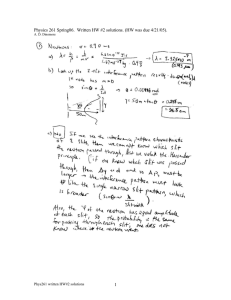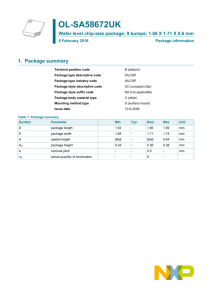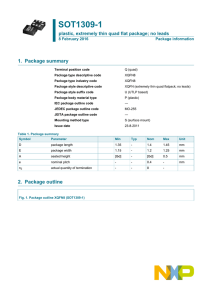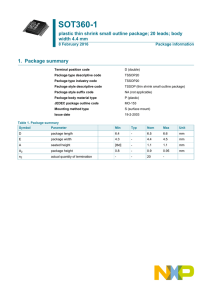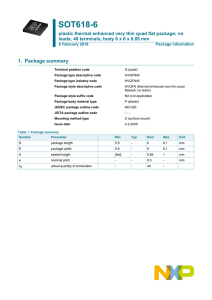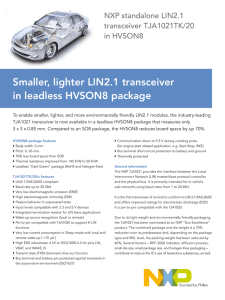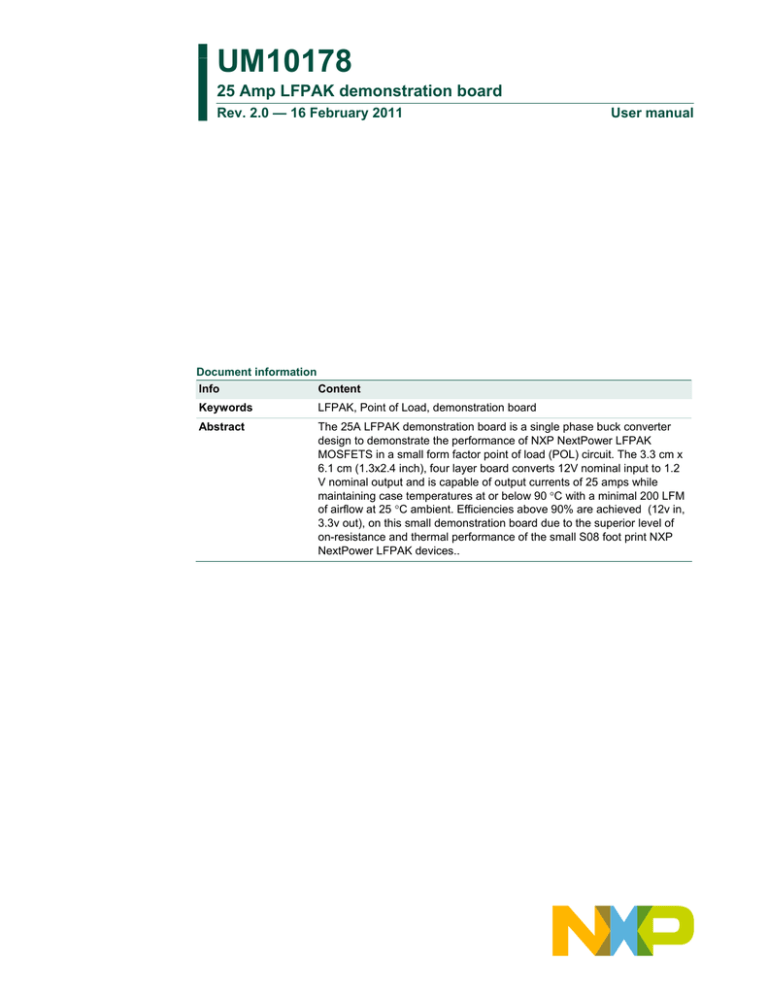
UM10178
25 Amp LFPAK demonstration board
Rev. 2.0 — 16 February 2011
User manual
Document information
Info
Content
Keywords
LFPAK, Point of Load, demonstration board
Abstract
The 25A LFPAK demonstration board is a single phase buck converter
design to demonstrate the performance of NXP NextPower LFPAK
MOSFETS in a small form factor point of load (POL) circuit. The 3.3 cm x
6.1 cm (1.3x2.4 inch), four layer board converts 12V nominal input to 1.2
V nominal output and is capable of output currents of 25 amps while
maintaining case temperatures at or below 90 °C with a minimal 200 LFM
of airflow at 25 °C ambient. Efficiencies above 90% are achieved (12v in,
3.3v out), on this small demonstration board due to the superior level of
on-resistance and thermal performance of the small S08 foot print NXP
NextPower LFPAK devices..
UM10178
NXP Semiconductors
Power SO-8 demonstration Board
Revision history
Rev
Date
Description
v 2.0
20110216
Document changed to comply with the new identity guidelines of NXP Semiconductors.
v 1.0
20060302
Initial version
Contact information
For more information, please visit: http://www.nxp.com
For sales office addresses, please send an email to: salesaddresses@nxp.com
UM10178
User manual
All information provided in this document is subject to legal disclaimers.
Rev. 2.0 — 16 February 2011
© NXP B.V.2011. All rights reserved.
2 of 17
UM10178
NXP Semiconductors
Power SO-8 demonstration Board
1. Introduction
The LFPAK demo board demonstrates the performance of NXP LFPAK MOSFETS in an
operational single-phase buck converter on a small 3.3cm x 6.1 cm board. The
innovative SOT669 LFPAK (Loss Free PacKage) has the compact footprint of the SO8
and enables a superior level of on-resistance and thermal performance by using an
underside thermal pad electrically connected to the drain.
The simple, low cost board is designed for operation from an input voltage of 12V
nominal, but is capable of operation from 5V to 13V. As furnished, the board output
voltage, Vout, is set to 1.2V. Vout can be adjusted from 0.8V to 5V by changing a resistor
on the board. The LFPAK devices used as examples on this board are the PH5525L for
the control MOSFET and PH2525L for the synchronous MOSFET. The MOSFETs are
rated at 25V and have max Rdson resistances of 5.5 mohm and 2.5 mohm respectively
(at VGS of 10V). For detailed specifications, refer to the respective MOSFET data
sheets. The demo board may have different MOSFETs that represent the latest NXP
NextPower MOSFET technology.
Fig 1 shows the FET footprint utilized on this board. The footprint is compatible with SO8
devices allowing SO8 packages to be used on this board if desired.
The TI TPS40077 controller was selected for its feature set which includes: voltage
operating range of 4.5V to 28V, high side current limit, source and sink drivers, and anticross conduction protection. For controller technical information, see the TI data sheet
for the TPS40077.
The board was designed as a simple low cost 25A reference design and is not intended
to demonstrate the maximum performance achievable from the chosen LFPAK devices.
The LFPAK devices on this board can be implemented in designs to achieve even
greater output currents and efficiencies if board design and component selection (such
as using a PWM controller with external high performance drivers) allow it.
Fig 1.
UM10178
User manual
Simplified outline
All information provided in this document is subject to legal disclaimers.
Rev. 2.0 — 16 February 2011
© NXP B.V.2011. All rights reserved.
3 of 17
UM10178
NXP Semiconductors
Power SO-8 demonstration Board
1.1 Board Top & Bottom Views
Fig 2 shows the top and bottom view of the board. All components are located on the
topside and clearance between components is arranged so attaching meters and probes
is convenient. Power input connections, power output connections, and mounting hole
pads are mirrored top and bottom.
019aab611
Fig 2.
UM10178
User manual
Top and bottom board views
All information provided in this document is subject to legal disclaimers.
Rev. 2.0 — 16 February 2011
© NXP B.V.2011. All rights reserved.
4 of 17
UM10178
NXP Semiconductors
Power SO-8 demonstration Board
1.2 Connection Details
Fig 3 shows the board connections. Input power and ground connection pads are at the
top of the board, and output power and ground connection pads at the bottom. The pads
are large and mirrored on the board top and bottom side for current handling capability.
Solder connections or alligator clips can used to make the power attachment. Soldering
to the connections pads will reduce the voltage drop of the connection. Small holes in the
input and output pads are sized so conductive posts can be inserted for oscilloscope and
meter probes. Mounting holes in the corners of the board are connected to power
ground.
Input pads
Gnd
Gnd
Vin
Gnd
Gnd
Gnd
Vout
Gnd
Output pads
Fig 3.
UM10178
User manual
019aab612
Input and output pads
All information provided in this document is subject to legal disclaimers.
Rev. 2.0 — 16 February 2011
© NXP B.V.2011. All rights reserved.
5 of 17
UM10178
NXP Semiconductors
Power SO-8 demonstration Board
2. Design Criteria
As supplied, the board is designed to provide an output voltage of 1.2V and 25A, but the
output voltage can be changed by replacing a resistor as explained below. The current
limits are also set for operation at 1.2 V. The operating frequency is set to 500 kHz. A
blue status LED at the top of the board lights when the controller and board are
operational. The 400nH inductor is a 30A device, (100°C), with a soft saturation curve,
and was selected to provide good efficiency due to its low 0.9 mohm DCR.
2.1 Board Features
As mentioned above, output voltage can be easily adjusted by changing the value of a
single resistor. The current limit can be adjusted, as described in Section 2.1.2 and will
need to be altered, when adjusting the board Vout, if a constant current limit is to be
maintained. The feedback path has been designed so that phase-gain testing can be
performed by removing a single resistor. A brief description these features are provided
below.
2.1.1 Vout selection
Replacing Ros with the values calculated in the equation below changes Vout.
.
Ros = R1 * Vs / (Vout – Vs)
Where Vs is the op amp reference voltage, and is fixed at 0.7V for the TPS40077.
Resistor values for common output voltages are provided in Fig 4.
Input pads
Gnd
Gnd
Vin
Gnd
Gnd
Gnd
Vout
Gnd
Output pads
Fig 4.
UM10178
User manual
019aab613
ROS Versus Vout
All information provided in this document is subject to legal disclaimers.
Rev. 2.0 — 16 February 2011
© NXP B.V.2011. All rights reserved.
6 of 17
UM10178
NXP Semiconductors
Power SO-8 demonstration Board
2.1.2 Control FET Current Limit
The TPS40077 data sheet discusses the parameters affecting the value of R10 for a
desired current limit. The voltage drop across R10 is compared with the voltage drop
across the control FET Rdson at full conduction, and initiates a shut down if the FET
exceeds VR10. The FET voltage drop is affected by the nominal values of Vout/Vin,
temperature, and output current. FET voltage drop is a direct function of Rdson, and thus
temperature dependent. The blue LED will flicker during cycle-to-cycle shutdown. Please
see the TPS40077 data sheet for additional information on current limit settings.
The demo board is shipped with R10 equal to 1180ohms, typically initiating a cycle-tocycle shutdown for currents exceeding 25A, (case temperatures ≤90 degC, Vin equal
12v). For other Vout and Vin values, R10 changes to provide this thermal protection.
Table 1 should assist in the selection. Note that there is variation in shutdown current
between demo boards, because of variation in Rdson between FETS.
Table 1.
Vout
Shutdown current limit
R10 for Vin = 12V
R10 for Vin = 10V
R10 for Vin = 8V
Shutdown Iout
0.8V
60.4K
634
832
1180
28A
1.2V
12.1K
1180
1540
1904
25A
1.5V
7.32K
1400
1820
2260
22A
2.5V
3.32K
2370
2670
2740
22A
3.3V
2.32K
2940
3090
3090
22A
5.0V
1.40K
2610
2610
2610
20A
[1]
Ros
Table note wide
a) Table note wide (level 2)
UM10178
User manual
All information provided in this document is subject to legal disclaimers.
Rev. 2.0 — 16 February 2011
© NXP B.V.2011. All rights reserved.
7 of 17
UM10178
NXP Semiconductors
Power SO-8 demonstration Board
2.1.3 Phase Gain Testing
Phase gain testing (Bode plots) can be performed by removing the zero ohm RFP
resistor and injecting a test signal across RTEST, a 50 ohm resistor as shown in Fig 5.
By monitoring the response at TP2 to the injected signal at TP1, a phase gain plot can be
generated by varying the frequency of the test signal. The full details of this test are
beyond the scope of this manual, but the measurements are easily done using a Vector
Network Analyzer (VNA). Please refer to the TPS40077 data sheet for loop
compensation techniques. The zero ohm RFP resistor should remain in the circuit for
normal operation.
Fig 5.
Phase-Gain Test Setup
UM10178
User manual
All information provided in this document is subject to legal disclaimers.
Rev. 2.0 — 16 February 2011
© NXP B.V.2011. All rights reserved.
8 of 17
UM10178
NXP Semiconductors
Power SO-8 demonstration Board
2.2 Board Schematic
The board schematic is shown in Fig 6
12 V
R5
820 Ω
R30
90.9 kΩ
C30
D1
1
0.1 μF
2
C5
22 nF
C1
5.6 nF
R20
46.4 kΩ
R4
332 kΩ
C10
10 pF
R10
1180 Ω
C6
22 μF
C12
22 μF
C13
22 μF
(empty)
C11
22 μF
(empty)
U1
KFF
RT
LVBP
PGD
SGND
SS
FB
COMP
R2
16.2 kΩ
C2
220 pF
ILIM
1
16
VDD
2
15
BOOST
3
14
HDRV
4
13
SW
TPS40077
5
12
DBP
6
11
LDRV
7
10
PGND
8
9
R3
150 Ω
C3
3.3 nF
RFB
1Ω
R1
8.66 kΩ
ROS(1)
12.1 kΩ
TP1 RTEST TP2
49.9 Ω
C20
0.1 μF
D
Q1
G
L1
0.4 μH
S
C17
0.1 μF
C4
1 μF
C14
100
μF
R9
2.2 Ω
C16
0.1 μF
(empty)
C9
2.2 nF
D
Q2
C18
0.1 μF
(empty)
VO
G
C7
100 μF
C8
100 μF
C15
100 μF
S
001aae417
Fig 6.
Schematic of the board
UM10178
User manual
All information provided in this document is subject to legal disclaimers.
Rev. 2.0 — 16 February 2011
© NXP B.V.2011. All rights reserved.
9 of 17
UM10178
NXP Semiconductors
Power SO-8 demonstration Board
2.3 Layout
The demo board is four layers, all layers plated with one-ounce copper. All signals are
routed top and bottom, with the inner layers servicing power and ground as shown in Fig
7. The board was designed to minimize high current induced noise in the input drive and
controller circuit areas. The input current flows in a tight loop between the input pads, the
input decoupling caps, and the MOSFETs. The output current is also confined to a
separate loop. The controller is placed outside either of these high noise power paths.
Power plane spits separate high current paths from sensitive circuit areas. The ground
plane is not split and uses component placement to keep noise from the switching
current out of sensitive circuit areas.
Top layer
Power layer
Bottom layer
Ground layer
019aab614
Fig 7.
Board layouts
UM10178
User manual
All information provided in this document is subject to legal disclaimers.
Rev. 2.0 — 16 February 2011
© NXP B.V.2011. All rights reserved.
10 of 17
UM10178
NXP Semiconductors
Power SO-8 demonstration Board
3. Electrical & Thermal Performance
The typical demo board, as designed, is capable of output currents of 25A with Vout set
o
to 1.2V (30W) and 23A with Vout set to 3.3V (76W). This rating is based on a 90 C
o
board temperature limit at 25 C ambient and airflow of 200LFM.
3.1 Efficiency Sweeps
Efficiency is plotted in Fig 8for Vout voltages of 1.2V and 3.3V. The input voltage is
o
12V for both sweeps. The maximum current swept is the level that produces 90 C FET
case temperatures. Higher currents can be achieved with greater airflow. The current
limit set point will need to be adjusted by changing R10 if higher currents are desired.
For a constant current output, the power output increases directly with Vout. The loss
factors do not increase nearly as fast, making conversion to higher Vout values more
efficient than conversion to lower Vout values.
019aab615
95
Eff
(%)
3.3 V Efficiency
90
85
1.2 V Efficiency
80
75
70
Fig 8.
0
5
10
15
20
AMPS
25
Efficiency sweeps 1.2V and 3.3V
UM10178
User manual
All information provided in this document is subject to legal disclaimers.
Rev. 2.0 — 16 February 2011
© NXP B.V.2011. All rights reserved.
11 of 17
UM10178
NXP Semiconductors
Power SO-8 demonstration Board
3.2 Thermal Sweeps
Fig 9 show the thermal case temperature of the control and sync FETs for the efficiency
sweeps in Figure 8. The load current is swept from zero amps to a maximum level,
o
which is defined when the average of the two case temperatures equals 90 C.
UM10178
User manual
All information provided in this document is subject to legal disclaimers.
Rev. 2.0 — 16 February 2011
© NXP B.V.2011. All rights reserved.
12 of 17
UM10178
NXP Semiconductors
Power SO-8 demonstration Board
Fig 9.
Thermal measurement for 12V in
UM10178
User manual
All information provided in this document is subject to legal disclaimers.
Rev. 2.0 — 16 February 2011
© NXP B.V.2011. All rights reserved.
13 of 17
UM10178
NXP Semiconductors
Power SO-8 demonstration Board
3.3 Electrical Waveforms
The oscilloscope plot in Fig 10 show the sync FET gate, control FET gate, switch Node,
for a no load and a 22 Amp load respectively.
Fig 10. Waveforms at no load
3.4 Loop Gain Phase Plot
Fig 11 shows the loop gain and phase vs. frequency for Vout=1.2V. The
compensation was very nearly the same for Vout ranges of 0.8V to 3.3V. The test
setup is shown in Fig 5 of this manual.
Fig 11. Phase gain plot of demonstration board
UM10178
User manual
All information provided in this document is subject to legal disclaimers.
Rev. 2.0 — 16 February 2011
© NXP B.V.2011. All rights reserved.
14 of 17
UM10178
NXP Semiconductors
Power SO-8 demonstration Board
4. Bill of Materials
Table 2.
LFPAK demo board BOM
Item
Qnt
Value
Package
Tolerance
Rating
Manuf
1
1
3.3nF
603
±10%
50V
TDK
C3
2
1
10pF
603
±10%
50V
TDK
C10
3
1
220pF
603
±10%
50V
TDK
C2
4
1
2.2nF
603
±10%
50V
TDK
C9
5
1
22nF
603
±10%
50V
TDK
C5
6
1
5.6nF
603
±10%
50V
TDK
C1
7
5
0.1uF
603
±10%
50V
TDK
C12, C20, C30,
(C16, C18 empty)
8
1
1uF
805
±10%
16V
TDK
C4
9
4
22uF
1210
+80%, -20%
16V
TDK
C6, C12,
(C11, C13 empty)
10
4
100uF
1812
+80%, -20%
6.3V
TDK
C7, C8, C14, C15
11
1
90.9k
603
±1%
R30
12
1
8.66k
603
±1%
R1
13
1
332k
603
±1%
R4
14
1
1180
603
±1%
R10
15
1
16.2k
603
±1%
R2
16
1
12.1k
603
±1%
ROS
17
1
46.4k
603
±1%
R20
18
1
150
603
±1%
R3
19
1
49.9
603
±1%
RTEST
20
1
2.2
805
±5%
R9
21
1
820
805
±5%
R5
22
1
1
603
±1%
RFB
23
1
TPS40077
SOP
TI
24
1
Control
LFPAK
NXP
Control
Q1
25
1
Sync
LFPAK
NXP
Sync
Q2
26
1
Blue LED
603
3.8V
Lite-On
LTSTC190UBKT
D1
27
1
744355047
WEHC/HCA
13x13
0.47uH,
26A
WÜRTH
744355047
L1
UM10178
User manual
±20%
Manuf P/N
TPS40077PWP U1
All information provided in this document is subject to legal disclaimers.
Rev. 2.0 — 16 February 2011
Designation
© NXP B.V.2011. All rights reserved.
15 of 17
UM10178
NXP Semiconductors
Power SO-8 demonstration Board
5. Legal information
5.1 Definitions
Draft — The document is a draft version only. The content is still under
internal review and subject to formal approval, which may result in
modifications or additions. NXP Semiconductors does not give any
representations or warranties as to the accuracy or completeness of
information included herein and shall have no liability for the consequences
of use of such information.
5.2 Disclaimers
Limited warranty and liability — Information in this document is believed to
be accurate and reliable. However, NXP Semiconductors does not give any
representations or warranties, expressed or implied, as to the accuracy or
completeness of such information and shall have no liability for the
consequences of use of such information.
In no event shall NXP Semiconductors be liable for any indirect, incidental,
punitive, special or consequential damages (including - without limitation lost profits, lost savings, business interruption, costs related to the removal
or replacement of any products or rework charges) whether or not such
damages are based on tort (including negligence), warranty, breach of
contract or any other legal theory.
Notwithstanding any damages that customer might incur for any reason
whatsoever, NXP Semiconductors’ aggregate and cumulative liability
towards customer for the products described herein shall be limited in
accordance with the Terms and conditions of commercial sale of NXP
Semiconductors.
Right to make changes — NXP Semiconductors reserves the right to make
changes to information published in this document, including without
limitation specifications and product descriptions, at any time and without
notice. This document supersedes and replaces all information supplied prior
to the publication hereof.
Suitability for use — NXP Semiconductors products are not designed,
authorized or warranted to be suitable for use in life support, life-critical or
safety-critical systems or equipment, nor in applications where failure or
malfunction of an NXP Semiconductors product can reasonably be expected
to result in personal injury, death or severe property or environmental
damage. NXP Semiconductors accepts no liability for inclusion and/or use of
NXP Semiconductors products in such equipment or applications and
therefore such inclusion and/or use is at the customer’s own risk.
Applications — Applications that are described herein for any of these
products are for illustrative purposes only. NXP Semiconductors makes no
representation or warranty that such applications will be suitable for the
specified use without further testing or modification.
Customers are responsible for the design and operation of their applications
and products using NXP Semiconductors products, and NXP
Semiconductors accepts no liability for any assistance with applications or
UM10178
User manual
customer product design. It is customer’s sole responsibility to determine
whether the NXP Semiconductors product is suitable and fit for the
customer’s applications and products planned, as well as for the planned
application and use of customer’s third party customer(s). Customers should
provide appropriate design and operating safeguards to minimize the risks
associated with their applications and products.
NXP Semiconductors does not accept any liability related to any default,
damage, costs or problem which is based on any weakness or default in the
customer’s applications or products, or the application or use by customer’s
third party customer(s). Customer is responsible for doing all necessary
testing for the customer’s applications and products using NXP
Semiconductors products in order to avoid a default of the applications and
the products or of the application or use by customer’s third party
customer(s). NXP does not accept any liability in this respect.
Export control — This document as well as the item(s) described herein
may be subject to export control regulations. Export might require a prior
authorization from national authorities.
Evaluation products — This product is provided on an “as is” and “with all
faults” basis for evaluation purposes only. NXP Semiconductors, its affiliates
and their suppliers expressly disclaim all warranties, whether express,
implied or statutory, including but not limited to the implied warranties of noninfringement, merchantability and fitness for a particular purpose. The entire
risk as to the quality, or arising out of the use or performance, of this product
remains with customer.
In no event shall NXP Semiconductors, its affiliates or their suppliers be
liable to customer for any special, indirect, consequential, punitive or
incidental damages (including without limitation damages for loss of
business, business interruption, loss of use, loss of data or information, and
the like) arising out the use of or inability to use the product, whether or not
based on tort (including negligence), strict liability, breach of contract, breach
of warranty or any other theory, even if advised of the possibility of such
damages.
Notwithstanding any damages that customer might incur for any reason
whatsoever (including without limitation, all damages referenced above and
all direct or general damages), the entire liability of NXP Semiconductors, its
affiliates and their suppliers and customer’s exclusive remedy for all of the
foregoing shall be limited to actual damages incurred by customer based on
reasonable reliance up to the greater of the amount actually paid by
customer for the product or five dollars (US$5.00). The foregoing limitations,
exclusions and disclaimers shall apply to the maximum extent permitted by
applicable law, even if any remedy fails of its essential purpose.
5.3 Trademarks
Notice: All referenced brands, product names, service names and
trademarks are property of their respective owners.
All information provided in this document is subject to legal disclaimers.
Rev. 2.0 — 16 February 2011
© NXP B.V. 2011. All rights reserved.
16 of 17
UM10178
NXP Semiconductors
Power SO-8 demonstration Board
6. Contents
1.
1.1
1.2
2.
2.1
2.1.1
2.1.2
2.1.3
2.2
2.3
3.
3.1
3.2
3.3
3.4
4.
5.
5.1
5.2
5.3
6.
Introduction .........................................................3
Board Top & Bottom Views ................................4
Connection Details .............................................5
Design Criteria.....................................................6
Board Features ..................................................6
Vout selection ......................................................6
Control FET Current Limit ..................................7
Phase Gain Testing............................................8
Board Schematic................................................9
Layout ..............................................................10
Electrical & Thermal Performance ...................11
Efficiency Sweeps ............................................11
Thermal Sweeps ..............................................12
Electrical Waveforms .......................................14
Loop Gain Phase Plot ......................................14
Bill of Materials..................................................15
Legal information ..............................................16
Definitions ........................................................16
Disclaimers.......................................................16
Trademarks ......................................................16
Contents.............................................................17
Please be aware that important notices concerning this document and the product(s)
described herein, have been included in the section 'Legal information'.
© NXP B.V. 2011.
All rights reserved.
For more information, please visit: http://www.nxp.com
For sales office addresses, please send an email to: salesaddresses@nxp.com
Date of release: 16 February 2011
Document identifier: UM10178

